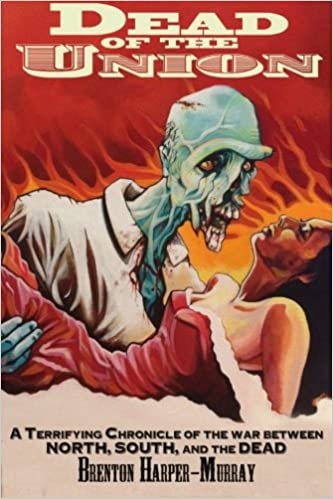Book Review: Dead of the Union
Dead of the Union. Brenton Harper-Murray. Holy Crow Press, November 2, 2012, Trade Paperback and Kindle, 214 pages.
Reviewed by Meghan Owen.
Want a better, good old fashioned, chew em’ up zombie story? Add in a rich but brutal historical period, such as the American Civil War, a classic yet under-utilized Patient Zero storyline and gritty realistic characters with combat-bred survival skills and you’ve got a zombie crisis that’ll go down in the history books. Brenton Harper-Murray brings all of these components and more together in his dark and inventive novel Dead of the Union.
The original printing of Dead of the Union was made possible by a successful Kickstarter, thus allowing Brenton Harper-Murray to self publish his novel. However, this isn’t the first time around publishing for the author. Harper-Murray has written several short stories in the genre of “strange fiction”. One story, after being set aside for a period of time, eventually fleshed out to be the 214-page novel we have today, Dead of the Union.
In a literary market already saturated with the trope of zombies, and the supernatural overlapping with the historical (i.e. Pride, Prejudice and Zombies}, Dead of the Union stands out because it doesn’t bank on the kitschy effect of taking an important figure from the past and mixing in a strange, otherworldly occupation (Abraham Lincoln: Vampire Hunter…cool, but it can only be done once). What makes the Dead of the Union float as a piece of fun historical fiction is that it focuses on everyday people of the era: a soldier, a spy and a widow. On top of that, the soldier and the spy have experience in both combat and the minimalist/survivalist aspects of war in the mid-1800s. So, their lengthy struggle against the zombie horde translates as believable. And, as for the widow, if you think a woman living alone on a farm for months has nothing to contribute to the apocalypse of the undead, you have another thing coming when you read Harper-Murray’s book.
Another refreshing element to Dead of the Union is its use of zombie lore. Instead of riffing off the causation of disease, biological warfare, or a mishap whilst diving in the Yang-Tze River, Harper-Murray’s novel focuses on the age-old origin of the “zombi” created by Voudon priests. Yet, instead of only utilizing the concept of soul-less bodies commanded by a skillful Voudon (such as the legend of coffee girls in New Orleans}, Dead of the Union incorporates modern zombie speed and appetite to boost the tension and give the incorporation of voodoo a strange and original flavor. Plus, this is no ordinary tale of a Voudon priest; this is also a tale of the Loa, and one of the most powerful and tricky Loa spirits, Baron Samedi. Those who have studied the top hat adorned, cigar smoking Lord of Dead, know that a story that includes Mr. Saturday can never be interpreted as boring.
The faulty aspects of Dead of the Union lay in its pacing. Any good story needs exposition, but it takes reading a decent chunk of the book in order to get to the action. Even then, once you’re there in the thick of it all, Harper-Murray will occasionally run with the logic that “quantity means quality,” and instead of simplifying the succinctness of the brain-bashing action, he’ll draw it out until it becomes a little redundant and overextended. Other than the pacing, the only other aspects that hinder Dead of the Union are that some of the characters have questionable intent, and there are some promising plot devices that get abandoned which cause the end of the novel to suffer a bit.
All that being said, Brenton Harper-Murray’s Dead of the Union is a delightfully gristly and suspenseful tale. It induces fear, disgust, wry amusement and unexpected sympathy. Harper-Murray has not only successfully invented a unique plot, but also a dense and magically bizarre environment. His use of zombies takes a common trope and spins it into an eerie, original book that makes you question if you’ve read The Zombie Survival Guide enough times to stand up to the monsters that Harper-Murray has skillfully created.

